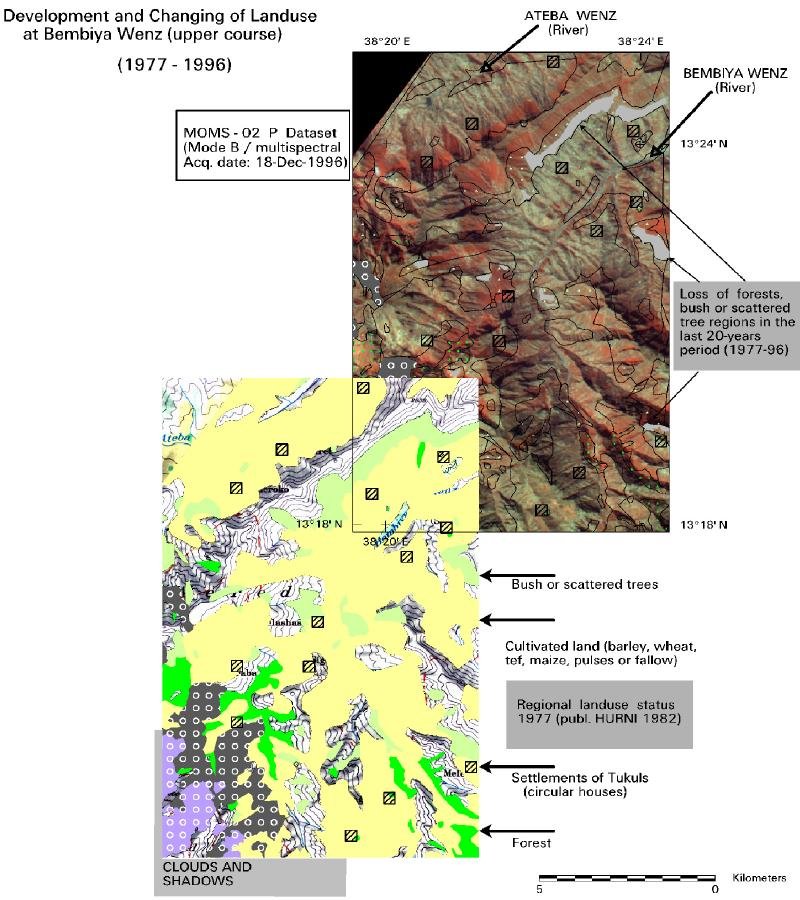Use of multispectral MOMS-02 data for geological interpretation and landuse change detection
After the successful shuttle mission (D2) of the German MOMS-02 sensor in 1993 and interpretations, the modified MOMS-2P (Modular Optoelectronic Multispectral Stereo Scanner) was established on the PRIRODA Module of the Russian Space Station MIR and worked in 1996 - 1998.
Data of the multispectral 4 band mode containing the visible and near infrared range (1: 440-505 nm; 2: 530-575 nm; 3: 645-680 nm; 4: 770-810 nm) with a spatial resolution of about 18 m are the basis for geological and structuralgeological interpretations, demonstrated in arid (Australia, Ethiopia) and semiarid-humid (Kyrgyztan) testareas.
The band design of the MOMS-2P multispectral mode B is focussed on the band combination 1/3/4 for vegetation analysis (landuse changes) and on the 1/2/4-combination for discrimination of Fe2+, 3+-bearing minerals which characterize soils and exposed lithological units.
Example 1: Landuse change detection in a dense-settle highplateau in the northern region of Amharen Highlands (NW of Lake Tana/Ethiopia)
The far-reaching consequences which result from dense settlement and intense agricultre for the high mountains area (espicially soil erosion) are known by a comparison of the documented landuse status of 1977 with the acquiry date of the MOMS-data set (December 1996).
The data, especially the spectral configuration of the bands 1 and 3 in combination with the spatial resolution of 18 meters enable the good discrimination of farmlands, woods, scateered trees and bush lands. The strongest modifications of landuse are recognizable in the region of the Bembiya river. Above the villages Gilbena and Atita is the broad rim of bush land to slack scattered tree vegetation between the willows lying higher and the farmlands disappeared. The area of cultivated farm land became apparent at the expense of natural vegetation above enlarged. Too above the small village Sabna and at all slopes above the small settlement Felashasigi, a such clear loss is available from bush land and natural vegetation. In the discussed area 20% of the natural vegetation cover would be allowed to have gone in a lost manner for instance in the last 20 years.
Example 2: Geological structure mapping of volcanic units (Ethiopia)
The interpretation example in the northern part of the Ethiopian Highlands shows a section from the Western Plateau of the Ethiopian Rift system (part of the Afro-Arabian Rift). The presented subset is situated at the NE slope of the Semien volcano cauldron subsidence, which is the highest plateau volcano of Ethiopia with an altitude of about 4600 m in the peak field. The complicated faulted basaltic to ignimbritic-rhyolitic volcanic sheets and volcanic effussions are expression of the starting extension tectonics in the oldest stages of the rift origin, with which before 40 - 15 million. years (Eocene - Miocene) that breaking-off of the African craton began.
The MOMS-02 data are combined by a Digital Elevation Model (DEM), which was derived from the global GTOPO30''-raster DEM data set of the US -Geological Survey / EROS Data Center. The combined interpretation of both sets enables (above) the detailed detection of subunits in the Tertiary regional main volcanic associations (Termaber-, Amba Aiba- und Ashangi-Basaltes). Die volcanics cover Mesozoic platform sediments Vulkanite (outcropping in the Kukayni Wenz valley).
The band design of the MOMS sensor system with the configuration of the bands 2 and 4 (Fe- modifications) in combination with the higher spatial resolution of about 18 m in the multispectral mode B enables the better discrimination chances of the wheatered volcanic rock units. It maakes clear that the about 2000 m thick main volcanic association is composed of some smaller effusions and basaltic flows and sheets (80-400 m thick). The detailed mapping enables the conclusions of the several stages volcanic subsidence process.
In the interpretation (below) Miocene echeloned volcano-tectonic fault systems at the flank of a graben system (detailed cauldron subsidence system) that the valley of the Kukanyni now follows (lower part of interpretation example), are to recognize. This fault system also displaces and cuts an older Oligocene graben system, which was already acting and configured before effusion of the Termaber basalts. The displacement amounts can achieve to about 700 m in the interpretation area.
In Co-operation with the Geological Survey of Israel characteristic structure units derived from a 400 km profile in NE Ethiopia are in strutural geological interpretation now (Precambrian basement/Mareb granite; Mesozoic platform units/Mekele outlier; Tertiary trappbasalts and volcanoes/Semien and Cenozoic recent volcanics/Danakil depression and Alid volcanic Range).



